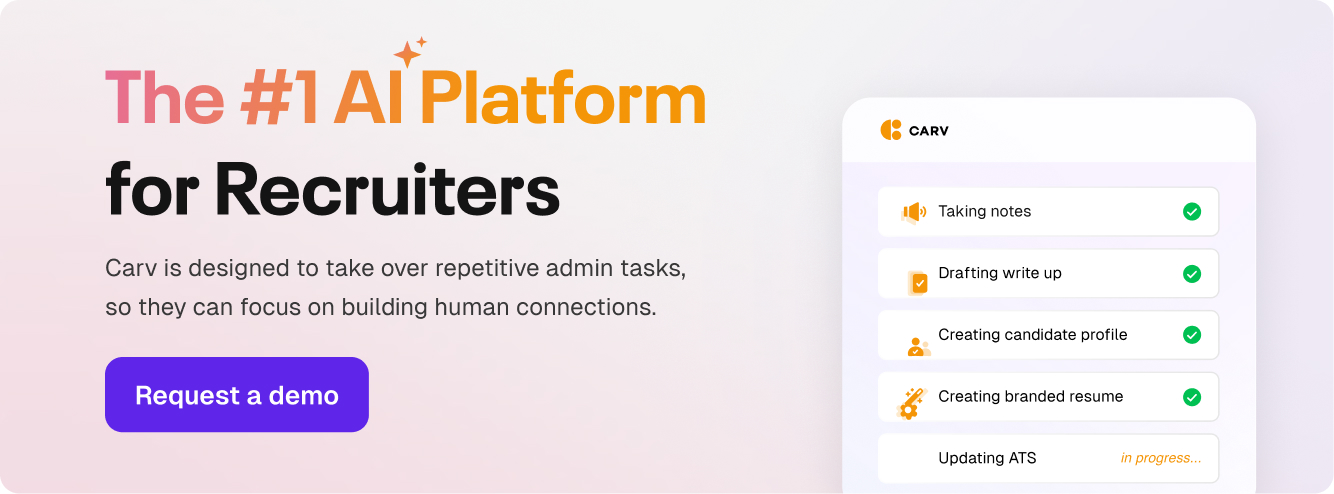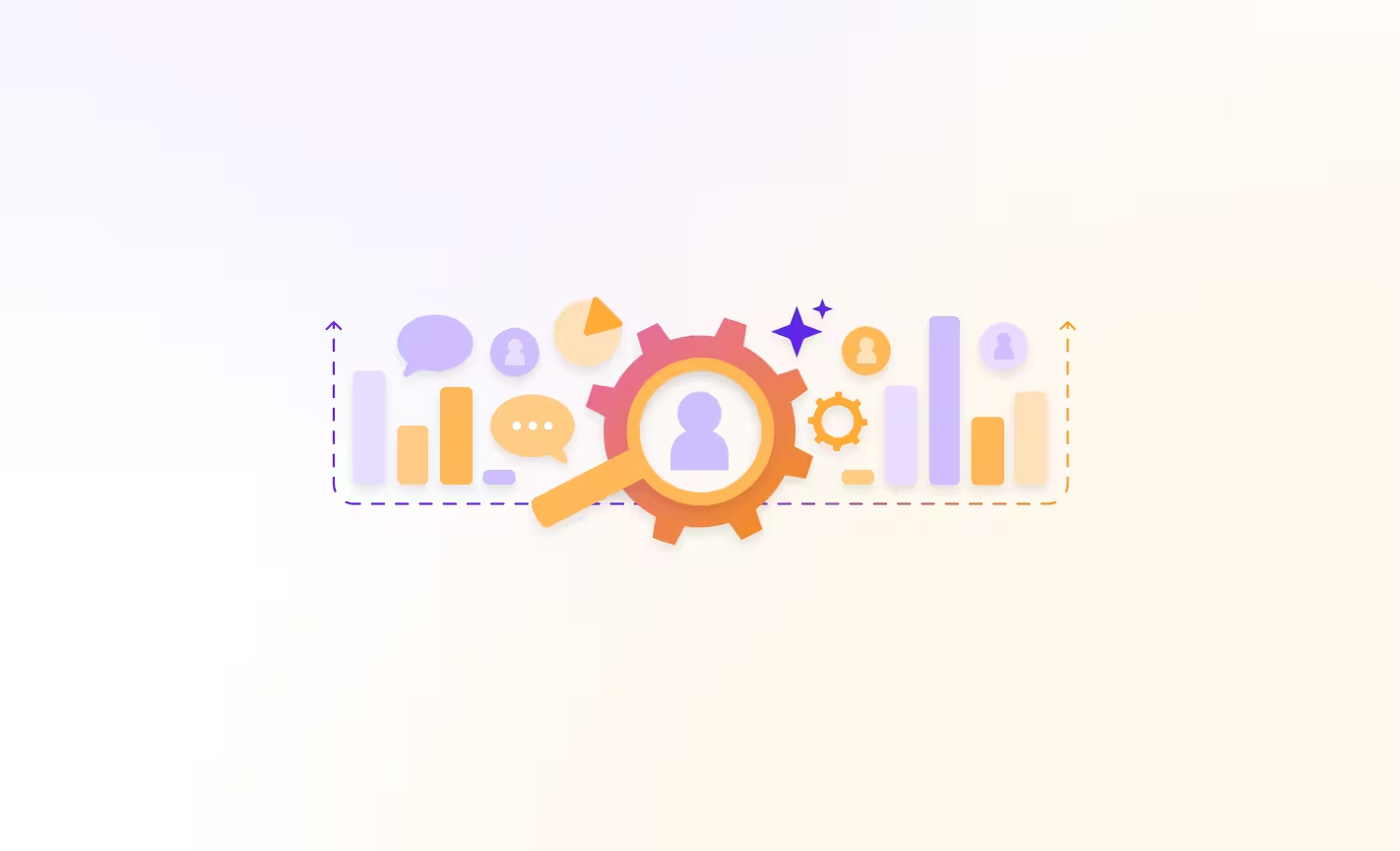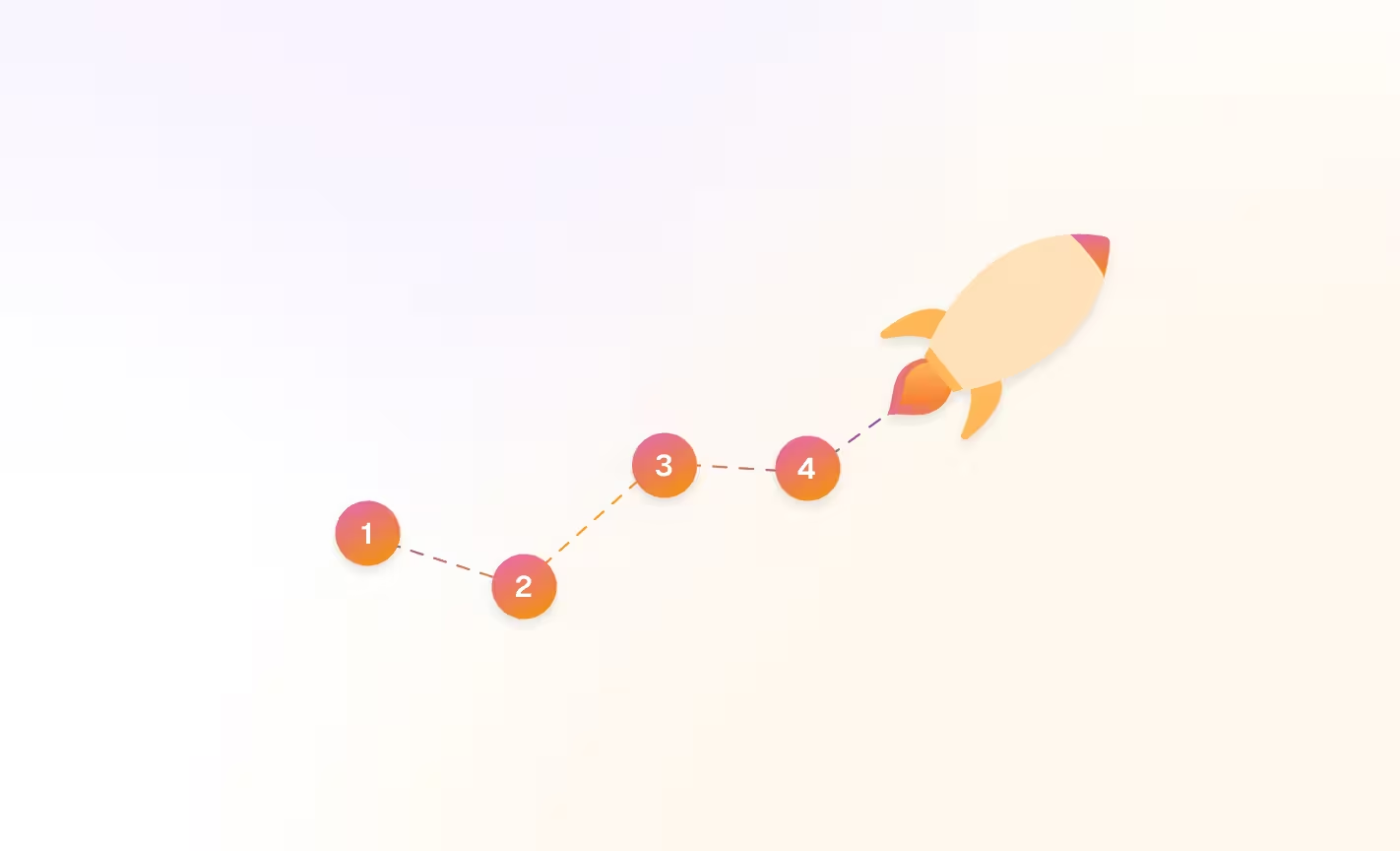The modern recruitment tech stack feels like a comfortable pair of shoes – familiar, reliable, with the trusty ATS at the center. It gets the job done in the way things have always been done.
But when we take a closer look, cracks begin to show.
Recruiters drown in administrative tasks, the candidate experience leaves much to be desired, and hiring managers or other stakeholders often lack the big picture. On top of that, recruitment operations teams wrestle with messy data and inaccurate reporting.
These are well-known pain points that come with most recruitment technology, and it's clear we need a better way.
But where should we start?
Our mission at Carv is to reimagine the recruitment process by integrating AI into the hiring workflows and facilitating recruiter-AI synergy.
The end goal?
Eliminate the administrative burden for recruiters, freeing them to focus on more fulfilling, strategic work. This is the first step towards AI-led recruitment, and it’s a step companies can already take today.
So let’s see how you can make this vision your reality.
The modern recruitment tech stack and its limitations
Before diving into the possibilities of artificial intelligence, let's get a clear picture of today's recruitment tech stack and its limitations.
ATS / CRM
At its core lies the ATS, used for client and candidate relationship management, tracking the candidate journey through the entire hiring process, and compiling recruitment metrics.
Most ATS systems even come with a built-in talent pool functionality for potential candidates. However, some companies choose to maintain their talent pool outside of the applicant tracking system, as a separate database. This generally includes passive candidates as well as qualified candidates who weren’t a good fit for current openings.
Sourcing software
Moving on, we encounter a series of candidate sourcing tools, the lifeblood of candidate discovery. This includes everything from established resume databases like Indeed or Monster to niche platforms like Github for developers or social media giants like LinkedIn.
Don't forget employee referral programs and industry-specific job boards – every avenue counts!
Candidate screening tools
Once the initial sourcing phase is complete, candidate screening tools take center stage. These streamline the evaluation process, helping recruiters identify promising candidates.
Phone screening apps facilitate quick interviews to assess basic qualifications and fit, while conversational recruitment tools powered by chatbots handle initial interactions. Video interviewing platforms then allow for remote interviews, making the process more flexible.

Assessment and interview tools
Next, we have assessment tools offering deeper insights. These can range from pre-employment skills assessments to psychometric tests that gauge personality and behavioral tendencies. For technical roles, coding challenges can accurately evaluate a programmer's abilities.
Streamlining the process further, interview scheduling tools automate communication and allow candidates to choose interview slots that work for them. Seamless integration with the recruiter's calendar ensures a smooth scheduling experience.
Recruitment marketing software
Finally, recruitment marketing platforms come into play. These tools focus on attracting top talent, encompassing career page management software for crafting compelling career sites, programmatic job advertising platforms for automated job postings, and social media recruitment tools to manage your employer brand and attract candidates through popular social media channels.
Once the recruitment journey ends, candidates are handed over to HR professionals, who rely on onboarding tools to manage new hire paperwork, communication, and training.
It's worth noting that many recruitment software providers offer features across multiple categories. For example, some ATS systems might already include basic sourcing tools or skills assessments.
Ultimately, the specific tech stack you choose depends on your company size, number of open roles or hiring volume, budget, and unique recruitment needs.
The built-in limitations of recruitment technology
While it's true that managing so many tools can make the recruitment process rather complex, the real challenge doesn’t come from the complexity of the tech stack, but from the limitations of recruitment technology when it comes to data management.
Firstly, if these tools aren’t perfectly integrated, it’s almost impossible to fully streamline the data flows and, consequently, the hiring process. Autonomous recruitment requires perfect data collection and processing for a seamless transfer of information between tools.
However, what we see today is that even in companies with complex infrastructure and automation in place, recruiters still spend 30% of their time on admin, copying data from one tool to the other.
A potential solution could be to simplify the tech stack so that TA teams spend less time on such tasks, but for most companies ripping and replacing existing systems isn't a realistic option. Not because no software out there can handle all parts of the recruitment cycle perfectly, but because of the already established workflows.
Recruitment teams aren’t looking to overhaul their entire infrastructure, because their tech stacks aren’t necessarily broken. They just come with intrinsic limitations, caused by the data formats they can process.
And this is the second major limitation: Regular recruitment technology cannot handle unstructured data.

An ATS can only work with data that’s formatted in a specific way, and comes in pairs of data type and data value. The number of predefined fields can vary, and some of these fields are pre-formatted as checkboxes and work as filters.
For example, if a candidate said they can’t relocate at the moment and that’s a knock-out criteria, the candidate will be disqualified. But later on you might have an opening in their current city - and you won’t be able to match that opening with the candidate, because you didn’t store all that information in the ATS.
And whether we like it or not, the reality is that no recruiter has the time to add all the information a candidate provides to the ATS or CRM, so a lot of data gets lost.
Why AI? In short: Unstructured data
The main sources of information in the recruitment process are intake calls and interviews. Next to these, we have resumes, cover letters, candidate social media profiles, and so on - but the real goldmine of applicant information lies in spoken data.
Both intakes and interviews are a source of unstructured data. So, if regular technology can’t handle such data, it’s no surprise that data quality suffers.

What usually happens is that after a call with a hiring manager or candidate, the recruiter has to listen back to the meeting and write down the summary or extract the highlights. Or, if they wrote down some notes during the call, they’ll go back and review their notes to add the data to the ATS.
Data gets lost in translation, and as a result, the right candidates can slip through the cracks.
AI, on the other hand, can perfectly handle unstructured data.
Artificial intelligence agents or assistants can listen to calls, understand the context, and translate that context into structured information that the other tools can use.
For example, Carv’s AI workmate can join a candidate interview, register what is said, and take notes for the recruiter. Later on, the spoken words are turned into meeting summaries, job descriptions, candidate profiles, and so on.

This is possible with generative AI, which has human-like capabilities: It can understand context, make connections, and predict the most correct meaning of the words and phrases in a conversation.
AI can work with audio, video, and written content, both when it comes to taking it in, and to creating output. So AI recruitment software like Carv can use interviews and intake calls as input data, along with resumes, cover letters, job requirement documents, and can create output documents such as candidate write-ups or profiles, job descriptions, and so on.
This is in short why gen AI is the perfect addition to the recruitment process. But where exactly does it fit into the tech stack?
Where AI fits in the recruitment tech stack
If AI can handle all this unstructured data, it can be the missing link in the recruitment process.
An AI-driven solution can be integrated with the ATS, CRM, sourcing tools, and so on, for an AI agent or assistant to go through all those data sources and create the most comprehensive candidate profile possible.
So if we look at what the reimagined AI-led tech stack looks like for recruiters, we can place the AI workmate at its core, right next to the ATS.

As AI recruitment technology evolves and TA teams get used to collaborating with AI for getting their work done, we might see a shift in infrastructure as well, with applicant tracking systems replaced by AI hiring tech.
But we’re not there yet, so for most teams, not much changes at first sight in the tech stack itself. However, a recruiter’s day is completely redefined once a gen AI solution is thrown into the mix.
We’ll use Carv as an example, to make this tangible.
Working alongside an AI workmate
Your day as a recruiter might still start with administrative work, such as reviewing yesterday’s activities, going through your candidate pipeline, or checking client communication. But instead of you doing all this work, it’s your AI workmate that handles most of the tasks.

You open your Carv dashboard and see what your AI workmate worked on since your last visit. You check the candidate profiles it reviewed, the job openings it created and launched, and how many job seekers it matched with your existing clients and their open roles.
Instead of spending 1-1.5 hours on checking emails, writing follow-ups, looking through resumes, or writing job requirement documents, you spend 10-15 minutes with your AI workmate, getting up to date and ready to move on to the main part of your day: Candidate interviews and client calls.
The AI workmate has prepared all the documents necessary for these calls, including notes from previous meetings, open action points, candidate write-ups for clients or hiring managers, and questions for next-round interviews with the best talent in your recruitment funnel.
.avif)
Carv has also handled all the interview scheduling for you, so you don’t need to spend hours preparing - you can go straight to your next meeting, equipped with all the information you need.
The AI workmate accompanies you during your meetings, whether they are physical, virtual, or phone calls, and takes all the notes, allowing you to fully focus on your candidate, client, or hiring manager.
After each interview or intake call, the workmate handles the follow-up tasks, keeping the talent acquisition process going: updating your ATS, writing follow-up emails or messages to shortlisted candidates, and moving the rejected but quality candidates to your Talent Space.

Carv creates the candidate write-ups for hiring managers and the hiring offers for the selected job seekers. Again, all this work happens in the backend while you continue your day and focus on one thing only: Having conversations with candidates and stakeholders.
At the end of the day, you can review all the work done by your AI assistant and customize your workflows to optimize the output that’s not perfect yet. Perhaps you want a different structure for a document or a different tone of voice to reflect your employer brand better.
You might spend a few minutes on these little tweaks, but you’ll never again have to spend hours on end-of-day admin tasks.

Please note that this reality doesn’t require you to overhaul any of your existing tools. You’re not replacing your ATS, and you’re not buying a new recruitment marketing platform.
What you’re doing instead is hiring another recruiter - this time, an AI recruiter who will become your TA team’s AI workmate.
And before you say you can’t afford to make this type of investment, we’ve done some calculations for you and can assure you that the ROI is there.
Your team will work more efficiently, have more breathing space to think through hiring decisions, and both your clients and candidates will benefit from a better experience.
So what do you need to do to get to this reality?
Building your AI-powered tech stack: First steps
Our approach is quite straight forward: Before implementing anything, take a moment to define your specific recruitment goals.
Are you aiming to reduce time-to-hire? Increase diversity in your talent pool, or speed up your sourcing efforts? Improve the recruiter and candidate experience? Clearly defined goals will guide your AI tech selection process.
First, map out your recruitment process from end to end, and identify the areas that aren’t working as they should.
For example, are you seeing high drop-off rates from one stage of the hiring process to the other? Or is your TA team spending too much time on specific steps of the talent acquisition process?

With this information at hand, identify the areas that can be improved by integrating AI into your recruitment tech stack.
You could aim to delegate all the admin to AI workmates, starting with admin tasks related to interviews and intake calls, for example, and building towards fully autonomous recruitment operations.
Once you know what you’re trying to achieve and why, it’s time to look at implications - from a data and people point of view.
Explore solutions to decide whether you’ll build your own AI agents, or you’ll use a plug-and-play AI recruitment software, and whether you need to increase your headcount or upskill and train your existing team.
Here are some key factors to consider when evaluating different solutions:
- Integration with existing systems: Will the AI tool integrate seamlessly with your existing ATS, CRM, and sourcing platforms? Disjointed systems can hinder efficiency gains.
- Budget and scalability: Consider the upfront and ongoing costs of the AI tool, and ensure it can scale to meet your growing recruitment needs.
- User-friendliness and training requirements: How easy is the AI tool to use for you and your team? Look for intuitive interfaces and factor in any training requirements.
Finally, build your implementation roadmap, taking all these points into consideration.

We encourage you to start small and test the waters first, just to mitigate risks and make sure your team is open to changing the way they handle the recruitment cycle. This will enable you to experience some quick wins without overhauling you entire infrastructure.
If you’d like to go deeper into this topic, book a demo below to discuss your needs and see Carv in action.



%20(1).avif)




